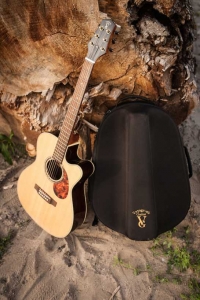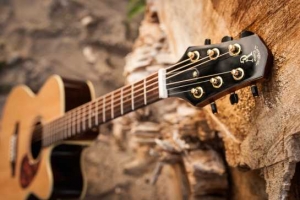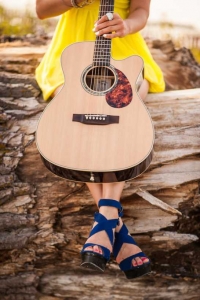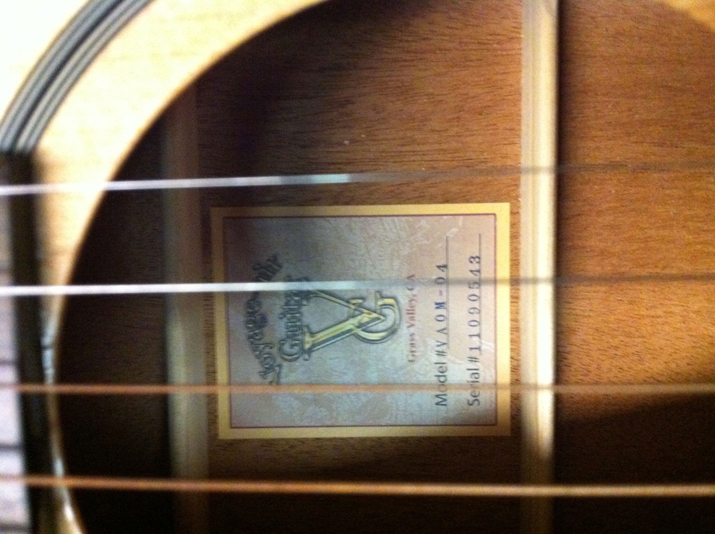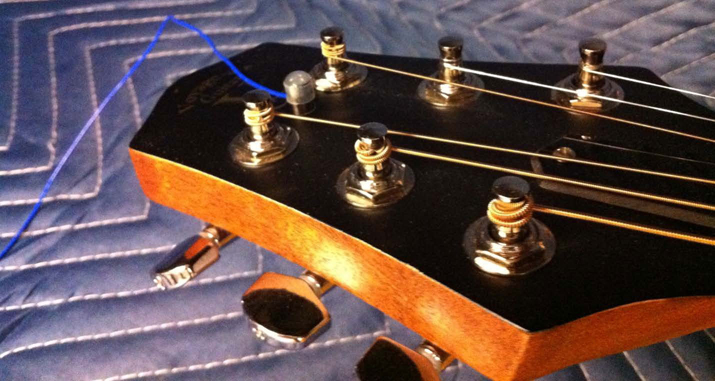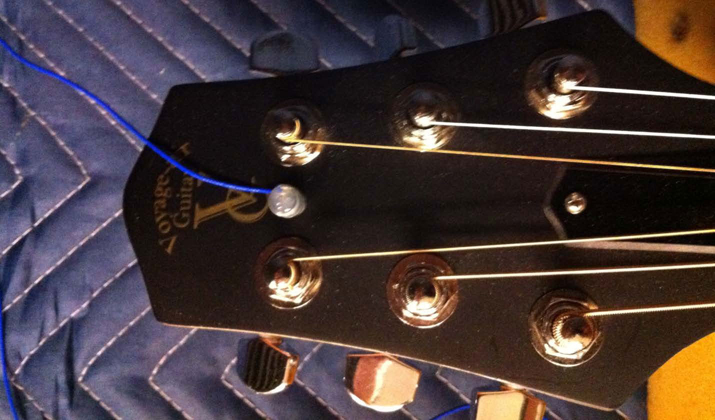Acoustic Guitar reviews a a full-size dreadnought with a folding neck for easy storage and travel.
By Jeffrey Pepper Rodgers
The headaches and hazards of traveling with a guitar, especially on ever-more-crowded airplanes, have inspired some clever designs: from really small guitars like the Martin Backpacker, Mini Martin, and Baby Taylor, to small headless solid-body instruments like the Traveler, to frame guitars that disassemble, like the SoloEtte or Yamaha Silent Guitar. Invented by luthier Harvey Leach, Voyage-Air guitars take a different approach: they are full-size guitars that downsize for traveling, thanks to a patented hinged neck that folds over the body. Packed up, a Voyage-Air fits into a soft case that’s ready for stowing in the overhead bin of an airplane (even meeting most airlines’ carry-on size requirements) or back of a car, as well as for carrying along wherever you have the urge to play.
Voyage-Air offers three lines of acoustic guitars: the Transit Series with all laminate woods, a mid-price Songwriter Series with solid tops and laminate backs and sides, and a Premier Series with all solid woods. The company makes dreadnought and OM models in all three lines, plus a short-scale mini-dreadnought in the Transit and Songwriter lines. For this review, I checked out a Songwriter Series VAD-04SN dreadnought and toted it along on some short trips.
Folding Design
The uniqueness of the Voyage-Air is clear right from a glance at its backpack-style Transit bag, which is roughly the size of a dreadnought body with about an inch of foam padding around the sides and includes a compartment on top that accommodates the folded-over neck. Zipping open the bag, I was greeted by the jarring sight of the neck upside down over the body, with the headstock resting on a padded strap over the lower bout, and the slack strings tucked inside the soundhole. The neck, which is cut through the heel just shy of the 14th fret, attaches to the body with a heavy-duty hinge. In one of the Voyage-Air’s many smart design features, the bolt that secures the neck doubles as a strap button.
When I went to reassemble the guitar, I held the body upright and raised the neck toward vertical, feeling the pull of the strings as they came up to tension (since I wasn’t initially muting the strings, they produced a brief and funny approximation of the beginning of the Looney Tunes theme). Not surprisingly, it takes a firm hand to bring the neck with six strings all the way, as flight attendants like to say, to the full upright position. But it’s entirely doable to use one hand to push the neck into place and the other hand to tighten the bolt that holds it there.
The speed with which the neck locked into position, even the first time I tried, was the first pleasant shock. The second, bigger shock was that since the guitar had been folded with the strings in tune, when I unfolded the neck, the Voyage-Air was as close to in tune as I’d expect any guitar to be after being shipped across country. I did need to tweak the strings a bit over the next few minutes, but no more than I normally would with any guitar.
Ready to Play
When the neck is unfolded, the VAD-04SN appears to be a nicely made, conventional dreadnought in the budget-to-middle price range, with a solid spruce top; laminated mahogany back and sides with light, orangey coloring; and a rosewood fingerboard. The ornamentation is simple, with fingerboard dots of staggered sizes, a rosette of three black rings, and a black pickguard with a decorative point near the waist.
At a closer look, some of the guitar’s unusual features become apparent—notably what Voyage-Air calls the “captured” nut. Instead of sitting in slots on top of the nut, the strings pass through holes in the nut and rest on a zero fret; this patented design holds the strings in position even when the neck is folded, making it much quicker and simpler to get the guitar ready to play. The heel of the Voyage-Air is bigger and wider than on a standard guitar because of the hinge hardware, and of course you can see a thin line where the heel is cut about a quarter inch from the body (the split on the fingerboard is nearly invisible when the neck is unfolded). But on the whole, there are few signs that this guitar was designed for travel; from across the room, or to an untrained eye, the Voyage-Air looks like a regular guitar.
And true to its billing, it feels and sounds like a regular guitar, too. My boom-chuck rhythm and bass runs had the projection and punch I expect to hear from a dreadnought. As I tried out some scales, the notes were clear, bright, and balanced from string to string. When playing above the tenth fret I did notice the larger-than-usual heel, but it wasn’t a major impediment; with a small adjustment to my left-hand position I could fluidly play single-note lines above the 12th fret.
The action, too, was comfortably low and buzz-free in first position as well as for barre chords and single-note lines up the neck. The guitar has a truss rod and comes with instructions on how to make adjustments. Voyage-Air’s website suggests that the neck may take time to settle into proper relief after being brought up to tension and acclimating to the temperature and humidity level, but I never found the need to break out the supplied Allen wrench. The guitar’s good factory setup held steady as I folded and unfolded the neck many times.
Hitting the Road
For my first outing, I brought the Voyage-Air to the university class I teach on songwriting. Normally I carry my laptop and books in a backpack and then schlep my heavy hardshell guitar case in one hand. The Voyage-Air’s Transit bag has a fairly roomy compartment with a laptop sleeve, so I thought I’d try to carry everything for class in the one bag: a 15-inch laptop, binder, book, and some stacks of papers along with the guitar. The bag was fairly stuffed and hefty at that point, but I loved walking up the hill to class with both hands free. And even better was unfolding the guitar in front of the wide-eyed students and quickly strumming a chord.
I also brought the Voyage-Air on a weekend road trip, loading up the bag with my laptop, umbrella, and a few sundry items. (The company’s higher-end models come with a different case, the Voyager, which includes a detachable laptop compartment that would be very handy—especially if you had to gate-check the guitar on a commuter plane.) I appreciated how much easier it was to fit the case in the car alongside the suitcases without an ungainly long neck getting in the way, and then it was sweet having an instrument to pick during downtime on my trip.
The best thing about playing the Voyage-Air is that you quickly forget it’s a travel guitar. This isn’t a good approximation of a real guitar; it’s a good guitar, with a tone and feel comparable to well-made instruments in its price range. Since it has a full-size body, the Voyage-Air is obviously not as compact as some travel instruments, but it’s a major improvement over a standard guitar for trekking around with. Anyone who wants to reduce the hassles of traveling with a guitar—without reducing the guitar itself—should check out Voyage-Air’s models.
Editors’ Impressions
Teja Gerken: The Voyage-Air VAD-04SN’s foldable neck is both a surefire conversation starter and a ticket to easy portability. But what’s also impressive is that the guitar is a great dreadnought for a little over $500. It has a nice low-end boom, its tone is balanced up and down the neck, and it has the volume and punch you’d expect from a spruce-and-mahogany dread. The guitar’s craftsmanship and finish is about as good as I’ve seen on a Chinese-made guitar, so whether it’s for a trip around the world or a bus ride to your lesson, the VAD-04SN is worth checking out.
Scott Nygaard: Most travel guitar designs tend to shrink the guitar’s body in some way, which is fine if the playing time on your travels is mostly confined to practicing or unwinding in your hotel room. But if you intend to check out the local bluegrass jam or song circle, and/or are just more comfortable with a dreadnought or jumbo-size instrument, the Voyage-Air VAD-04SN is a great solution. Costing less than most flight cases, the VAD-04SN’s sound is big and balanced and the neck is easy to navigate.
taken from acguitar.com




